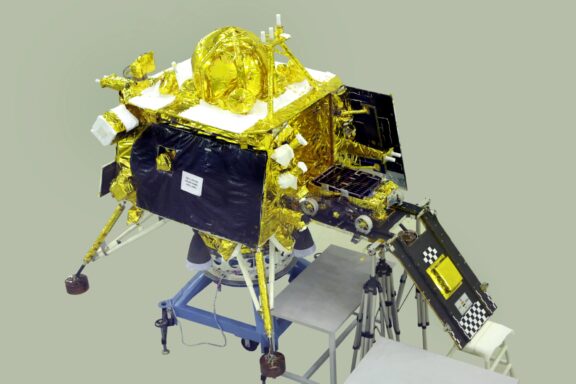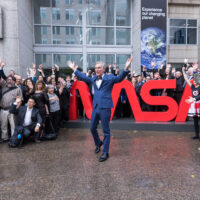Chandrayaan-3, India's Moon lander and rover
Highlights
- Chandrayaan-3 was a Moon lander and rover mission by India’s space agency.
- The spacecraft launched on July 14, 2023 and touched down in the Moon’s south polar region on August 23, 2023.
- The Chandrayaan-3 lander and rover were equipped with science instruments designed to deepen our understanding of the Moon.
What is Chandrayaan-3?
Chandrayaan-3 is the third Moon mission by India’s space agency. The goal was to place a lander and rover on the lunar surface and operate them for roughly one lunar day, or 14 Earth days. The small rover, which weighs just 26 kilograms (57 pounds), flew to the Moon inside the lander. Both vehicles were equipped with science instruments to study the surface.
Chandrayaan-3 completed a soft landing in the Moon's south polar region on August 23, 2023.

The Chandrayaan-3 lander and rover were similar in design to those from the Chandrayaan-2 mission. In September 2019, the Chandrayaan-2 Vikram lander successfully lowered itself to within 5 kilometers (3 miles) of the Moon, entering a “fine braking” mode that would have placed it gently on the lunar surface. Like its successor, Chandrayaan-2 was targeting the Moon’s south polar region, where ice has been found inside permanently shadowed craters.
A software glitch caused Vikram to veer off course, and ISRO officials lost contact with the spacecraft. NASA’s Lunar Reconnaissance Orbiter later found debris from the vehicle scattered about 750 meters (a half mile) from the intended landing area.
The mission was not a total loss: Chandrayaan-2 also included an orbiter that continues to study the Moon from above. Among other scientific functions, the orbiter is equipped to scan for water ice.
Chandrayaan-3 does not include an orbiter, although the propulsion module that will carry the lander to lunar orbit was equipped with a science instrument that will observe Earth as if it were an exoplanet, providing data for future exoplanet studies.

How did Chandrayaan-3 get to the lunar surface?
From liftoff to touchdown, it took about 40 days to place Chandrayaan-3 on the lunar surface.
The mission began on July 14, 2023 with a launch aboard India’s LVM3 rocket, the country’s heavy lift vehicle capable of placing about 8 metric tons into low-Earth orbit. (For comparison, the SpaceX Falcon 9 rocket can lift almost 23 metric tons to low-Earth orbit.)
The LVM3 placed the spacecraft and an attached propulsion module into an elongated Earth orbit with an apogee, or high point, of about 36,500 kilometers (22,700 miles) above the planet. The propulsion module raised its orbit several times before transferring into lunar orbit.
At the Moon, the propulsion module lowered Chandrayaan-3 until it reached a circular, 100-kilometer (62-mile) orbit. There, the two vehicles separated, leaving the lander to deorbit and touch down in the Moon’s south polar region. At the moment of contact, the lander was expected to move less than 2 meters per second vertically, and 0.5 meters per second horizontally (6.5 and 1.6 feet per second, respectively).

What did Chandrayaan-3 do on the Moon?
A successful touchdown marked a huge achievement for ISRO, placing them in a small group of nations that have landed spacecraft on other worlds. Beyond this milestone, Chandrayaan-3 had technologies to demonstrate and science to perform.
Shortly after landing, Chandrayaan-3 lander released the Pragyan rover to explore the lunar environment.
The solar-powered lander and rover had about two weeks to study their surroundings. They were not designed to survive the chilly lunar night. The rover could only communicate with the lander, which communicates directly with Earth.
The rover had two payloads:
- Laser Induced Breakdown Spectroscope (LIBS): Determines the chemical and mineralogical composition of the surface.
- Alpha Particle X-ray Spectrometer (APXS): Determines the elemental composition of the surface. ISRO specifically mentions magnesium, aluminum, silicon, potassium, calcium, titanium, and iron as elements the rover will hunt.
The lander had four payloads:
- Radio Anatomy of Moon Bound Hypersensitive ionosphere and Atmosphere (RAMBHA): Measures how the local gas and plasma environment changes over time.
- Chandra’s Surface Thermophysical Experiment (ChaSTE): Studies the surface’s thermal properties.
- Instrument for Lunar Seismic Activity (ILSA): Measures seismic activity at the landing site in order to delineate the subsurface crust and mantle.
- Laser Retroreflector Array (LRA): A NASA-provided retroreflector that allows for lunar ranging studies. Laser ranging is the process of zapping a reflector with a laser and measuring the time it takes for the signal to bounce back. NASA still measures the distance to the Moon using retroreflectors left behind during the Apollo program.
Support missions like Chandrayaan-3
Whether it's advocating, teaching, inspiring, or learning, you can do something for space, right now. Let's get to work.


 Explore Worlds
Explore Worlds Find Life
Find Life Defend Earth
Defend Earth


